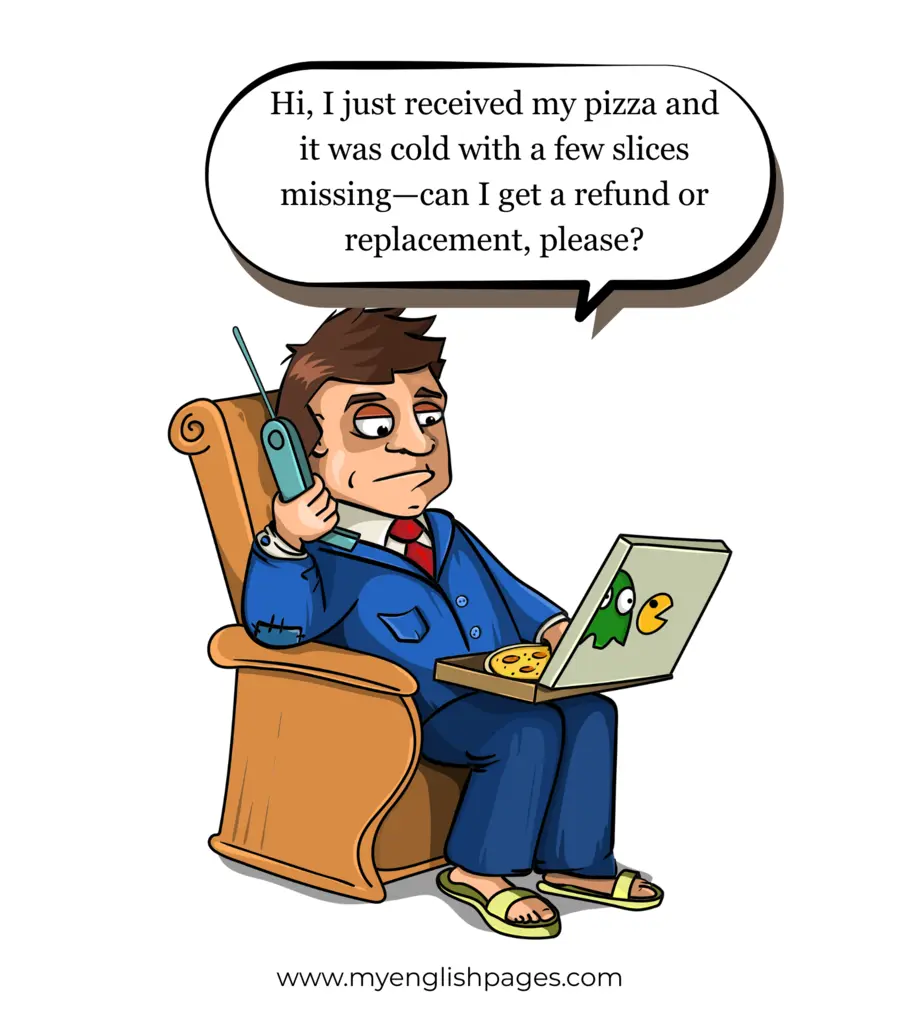Table of Contents
Introduction
We all need to make complaints from time to time. This usually happens when you’re served cold food at a restaurant, have a noisy neighbor, or have been delivered a broken product.
For English learners, knowing how to make a complaint politely and effectively is an important skill. This making a complaint exercise will help students practice common phrases, expressions, and responses for everyday situations.
This blog post includes vocabulary, example dialogues, and interactive exercises to help learners become more confident in speaking up when things go wrong.
Key Vocabulary Expressions for Making Complaints in English
Before we begin, here are some useful expressions and vocabulary that are commonly used when making complaints:
- I’m afraid there’s a problem with…
- I’d like to make a complaint.
- This is unacceptable.
- I’m not satisfied with…
- Could you do something about this?
- There seems to be a mistake.
- I’d appreciate it if you could…
- Sorry for the inconvenience. (response)
- Let me fix that for you right away. (response)
Making Complaints Exercises with Answers
Exercise 1: Match the Complaint with the Response
Instructions: Match each complaint with the most appropriate response by writing the letter of the response next to the number of the complaint.Complaints Responses 1. I’m afraid the food is cold. a. We’ll check with the courier and get back to you shortly. 2. I’m sorry, but my room is very noisy. b. I understand. We’ll ask the workers to stop before 9 p.m. 3. It seems there is a problem with the product. It doesn’t work. c. I’m sorry about that. Would you like to move to another seat? 4. This is unacceptable. I was charged twice. d. Oh no! I’ll contact our billing department to fix this. 5. I have a complaint about the internet. It is too slow. e. We’re having technical issues today, but our team is working on it. 6. I am sorry to say it, but my seat is broken. f. I apologize. Let me issue a refund or replace it for you. 7. It seems that the delivery is late. g. I’m really sorry. I’ll bring you a hot meal right away.
2. → b
3. → f
4. → d
5. → e
6. → c
7. → a
Exercise 2: Fill in the Blanks
Instructions: Complete the complaints using the correct word from the options in parentheses.
- I’m sorry, but this item is ________ (defective / polite / excellent).
- I’d like to ________ a complaint about the service. (say / make / write)
- There seems to be a ________ with my order. (problem / solution / cake)
- Could you ________ something about it? (do / give / write)
- This room doesn’t ________ the description online. (match / sell / clean)
- I was expecting better ________ from a five-star hotel. (weather / service / dinner)
- I’m afraid my package hasn’t ________ yet. (eaten / arrived / broken)
2 → make
3 → problem
4 → do
5 → match
6 → service
7 → arrived
Exercise 3: Choose the Right Option
Instructions: For each question, choose the most appropriate, polite, or formal expression for making a complaint. Then discuss why it’s the best choice.
- 1. Which of these is the most polite way to complain?
- A) This is awful! I want a refund now!
- B) I’m not happy with this service.
- C) I’m sorry, but I have a concern about the service I received.
- 2. Which of these is the least formal?
- A) Hey, this thing’s broken. What can you do about it?
- B) I’m afraid the item doesn’t work as expected.
- C) There appears to be a defect with this product.
- 3. Which of these is the most direct and potentially rude?
- A) I want to speak to your manager—now!
B) Could I please speak to someone in charge?
C) Is there someone I could talk to about this issue?
- A) I want to speak to your manager—now!
- 4. Which of these shows the highest level of politeness?
- A) This isn’t working. Fix it.
- B) Would you mind helping me with this problem?
- C) You need to do something about this.
- 5. Which of these is the most formal complaint?
- A) I’m not too happy about this.
- B) I’d like to formally express my dissatisfaction.
- C) This sucks.
2 → A
3 → A
4 → B
5 → B
Exercise 4: Dialogue Completion – Making a Complaint
Instructions: Complete the dialogue using the words and expressions from the box. Then, practice the conversation with a partner.4
Word/Expression Bank:
- fix it
- make a complaint
- appreciate
- isn’t working
- I’m sorry to hear that
- the inconvenience
- Customer: Excuse me, I’d like to __________.
- Manager: __________. What seems to be the problem?
- Customer: The air conditioner in my room __________, and it’s very hot.
- Manager: I apologize for __________. Let me send someone to __________ immediately.
- Customer: Thank you. I __________ your help.
2 → I’m sorry to hear that
3 → isn’t working
4 → the inconvenience
5 → fix it
6 → appreciate
Exercise 5: Dialogue Writing
Task: Now try your own version. Think of a problem you’ve had in a hotel, restaurant, or shop. Write your complaint and how the staff might respond.
Tips for Making Polite Complaints in English

- Use softening language: “I’m afraid…” or “It seems that…”
- Stay calm and respectful—even when you’re upset.
- Give details about the problem clearly and politely.
- Listen to the other person’s response.
Polite vs. Impolite Complaints
Using polite language makes your complaint more effective and respectful. Here’s a quick guide:
| Impolite Complaint | Polite Version |
|---|---|
| This is awful! Fix it now. | I’m sorry, but there seems to be a problem. Could you help me? |
| I want a refund—this is unacceptable. | I’d like to request a refund, please. |
| Your service is terrible. | I’m not satisfied with the service I received. |
| This thing is broken. What now? | I’m afraid this item doesn’t work. Could you take a look at it? |
| You messed up my order! | I think there’s been a mistake with my order. |
Conclusion
The above “making complaints exercises” will help learners gain the skills they need to speak up politely and clearly. These activities can be used in your classroom or for self-study.
Looking for more real-life communication practice?
Check out our posts on:


